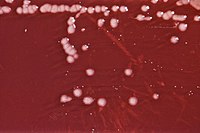
Photo from wikipedia
Pseudomonas aeruginosa is a ubiquitous bacterium found in many natural and man-made environments. It is also a pathogen for plants, animals, and humans. As for almost all living organisms, iron… Click to show full abstract
Pseudomonas aeruginosa is a ubiquitous bacterium found in many natural and man-made environments. It is also a pathogen for plants, animals, and humans. As for almost all living organisms, iron is an essential nutrient for the growth of P. aeruginosa. The bacterium has evolved complex systems to access iron and maintain its homeostasis to survive in diverse natural and dynamic host environments. To access ferric iron, P. aeruginosa is able to produce two siderophores (pyoverdine and pyochelin), as well as use a variety of siderophores produced by other bacteria (mycobactins, enterobactin, ferrioxamine, ferrichrome, vibriobactin, aerobactin, rhizobactin and schizokinen). Furthermore, it can also use citrate, in addition to catecholamine neuromediators and plant-derived mono catechols, as siderophores. The P. aeruginosa genome also encodes three heme-uptake pathways (heme being an iron source) and one ferrous iron acquisition pathway. This review aims to summarize current knowledge concerning the molecular mechanisms involved in all the iron and heme acquisition strategies used by P. aeruginosa. This article is protected by copyright. All rights reserved.
Journal Title: Environmental microbiology
Year Published: 2022
Link to full text (if available)
Share on Social Media: Sign Up to like & get
recommendations!